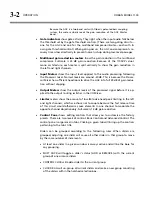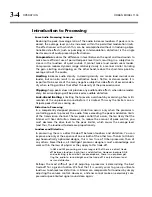
3-12
OPERATION
ORBAN MODEL 1100
Low-IM Look-ahead Limiter:
OPTIMOD-PC’s peak limiter prevents overshoots by
examining a few milliseconds of the unprocessed sound before it is limited. This
way, the limiter can anticipate and control peaks.
It is important to minimize audible peak-limiter-induced distortion when
one is driving a low bitrate codec because one does not want to waste
precious bits encoding the distortion. Look-ahead limiting can achieve
this goal; hard clipping cannot.
One can model any peak limiter as a multiplier that multiplies its input
signal by a gain control signal. This is a form of amplitude modulation.
Amplitude modulation produces sidebands around the “carrier” signal.
In a peak limiter, each Fourier component of the input signal is a sepa-
rate “carrier” and the peak limiting process produces modulation side-
bands around each Fourier component.
Considered this way, a hard clipper has a wideband gain control signal
and thus introduces sidebands that are far removed in frequency from
their associated Fourier “carriers.” Hence, the “carriers” have little ability
to mask the resulting sidebands psychoacoustically. Conversely, a look-
ahead limiter’s gain control signal has a much lower bandwidth than that
of a clipper and produces modulation sidebands that are less likely to be
audible.
Simple wideband look-ahead limiting can still produce audible inter-
modulation distortion between heavy bass and midrange material. The
look-ahead limiter in your Optimod uses sophisticated techniques to re-
duce such IM distortion without compromising loudness capability.
Two-Band Purist Processing
OPTIMOD-PC’s two-band algorithm can be set to be phase-linear. We believe that
this is the ideal processing for classical music and jazz programming because it does
not dynamically re-equalize high frequencies; the subtle HF limiter only acts to re-
duce high frequency energy when it would otherwise cause overload because of the
TV preemphasis curve. OPTIMOD-PC’s two-band phase-linear structure therefore
keeps the musical spectrum coherent and natural.
Input/output Delay
The input/output time delay of the processing is typically 19 ms—approximately
two-thirds of an NTSC frame. To make intelligent decisions about how to process,
OPTIMOD-PC needs to look ahead at the next part of the program waveform. As
digital transmission processing advances further and further from its analog roots,
this is the inevitable price of progress.
To avoid lip sync problems in video applications, OPTIMOD-PC allows you to pad the
delay to one full frame of 24, 25, or 29.97 fps video, which makes matching audio
and video delays convenient. See step (3.D) on page 2-22.
Содержание OPTIMOD-PC 1100
Страница 1: ...Operating Manual OPTIMOD PC 1100 Digital Audio Processor on a PCI Sound Card Software Version 2 0...
Страница 4: ......
Страница 5: ...Operating Manual OPTIMOD PC 1100 Digital Audio Processor on a PCI Sound Card Software Version 2 0...
Страница 18: ......
Страница 54: ......
















































